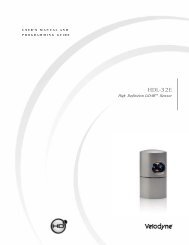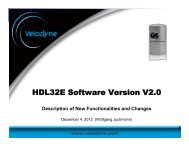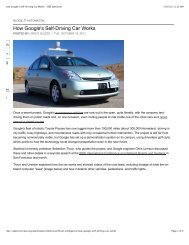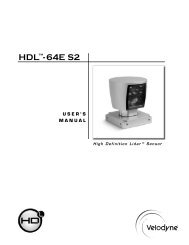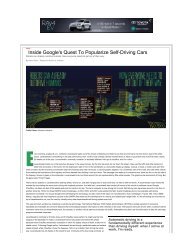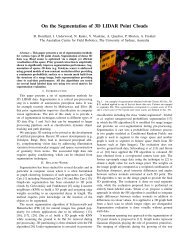HDLâ¢- 64E - Velodyne Lidar
HDLâ¢- 64E - Velodyne Lidar
HDLâ¢- 64E - Velodyne Lidar
You also want an ePaper? Increase the reach of your titles
YUMPU automatically turns print PDFs into web optimized ePapers that Google loves.
Case 20ft: Det Laser Power av,rot = 2.404 [mJ/m 2 ] * 31.25 [kHz] * 1 * 1 * .75 * .0013<br />
= 0.07 W/m 2<br />
Case 30ft: Det Laser Power av,rot = 1.227 [mJ/m 2 ] * 31.25 [kHz] * 1 * 1 * .75 * .0009<br />
= 0.02 W/m 2<br />
Case 100ft: Det Laser Power av,rot = 0.146 [mJ/m 2 ] * 31.25 [kHz] * 1 * 1 * .75 *<br />
.0003 = 0.001 W/m 2<br />
The MPE average power Table A1 (using 10 s emission duration),<br />
MPE AV = 10 * C 4 * C 7 W/m 2<br />
Where C 4 is derived in Condition 1 = 2.57<br />
And C 7 is derived from Table 10 = 1<br />
MPE AV = 25.7 W/m 2<br />
Condition 2 Conclusion<br />
Since all Cases are lower than the MPE AV , the Product has no ENOHD for this Condition.<br />
Condition 3: Repetitive Pulse Maximum Permissible Exposure Limit (10 second exposure)<br />
The calculated emission from ENOHD Condition 1 will be used to check for this Condition.<br />
Case 4mm: Detected Laser Energy Density SP = 0.833 mJ/m 2<br />
Case 100mm: Detected Laser Energy Density SP = 0.821 mJ/m 2<br />
Case 1ft: Detected Laser Energy Density SP = 1.183 mJ/m 2<br />
Case 5ft: Detected Laser Energy Density SP = 1.417 mJ/m 2<br />
Case 10ft: Detected Laser Energy Density SP = 2.153 mJ/m 2<br />
Case 16ft: Detected Laser Energy Density SP = 2.292 mJ/m 2<br />
Case 20ft: Detected Laser Energy Density SP = 2.404 mJ/m 2<br />
Case 30ft: Detected Laser Energy Density SP = 1.227 mJ/m 2<br />
Case 100ft: Detected Laser Energy Density SP = 0.146 mJ/m 2<br />
We must determine the number of laser emissions that will illuminate the detector over a<br />
period of 10 seconds to calculate to MPE train, SP . This number shall be calculated using the<br />
following formula:<br />
N = [Pulse Repetition Rate] * [Laser Overlap] * [Head Overlap] * [Sequential Duty Cycle] *<br />
[Rotation Factor] * [Illumination Duration]<br />
C 5 = N -0.25<br />
However, if multiple optical pulses occur within an T i (18us period as defined by Table 3),<br />
they are considered as a single pulse to determine N, and the energies of the individual<br />
pulses are added to compared to MPE of T i . This is the case in Cases 14mm, 100mm and<br />
1ft. For these Cases the number is calculated using the following formula.<br />
N = [Rotation Factor] * [Sequential Duty Cycle] * [Head Overlap] * [Illumination Duration] /<br />
[T i ]<br />
C 5 = N -0.25<br />
Case 14mm: C 5 = {.0796 * 0.75 * 2 * 10 [s] / 18 [us]} -0.25 = .0623<br />
Case 100mm: C 5 = {.0428 * 0.75 * 2 * 10 [s] / 18 [us]} -0.25 = .0728<br />
Case 1ft: C 5 = {.0204 * 0.75 * 2 * 10 [s] / 18 [us]} -0.25 = .0876<br />
Case 5ft: C 5 = {31.25 [kHz] * 2 * 2 * 0.75 *.0049 * 10[s]} -0.25 = .121<br />
Case 10ft: C 5 = {31.25 [kHz] * 1 * 2 * 0.75 *.0025 * 10[s]} -0.25 = .170<br />
Case 16ft: C 5 = {31.25 [kHz] * 1 * 2 * 0.75 *.0016 * 10[s]} -0.25 = .191<br />
Case 20ft: C 5 = {31.25 [kHz] * 1 * 1 * 0.75 *.0013 * 10[s]} -0.25 = .239<br />
- 20 -




